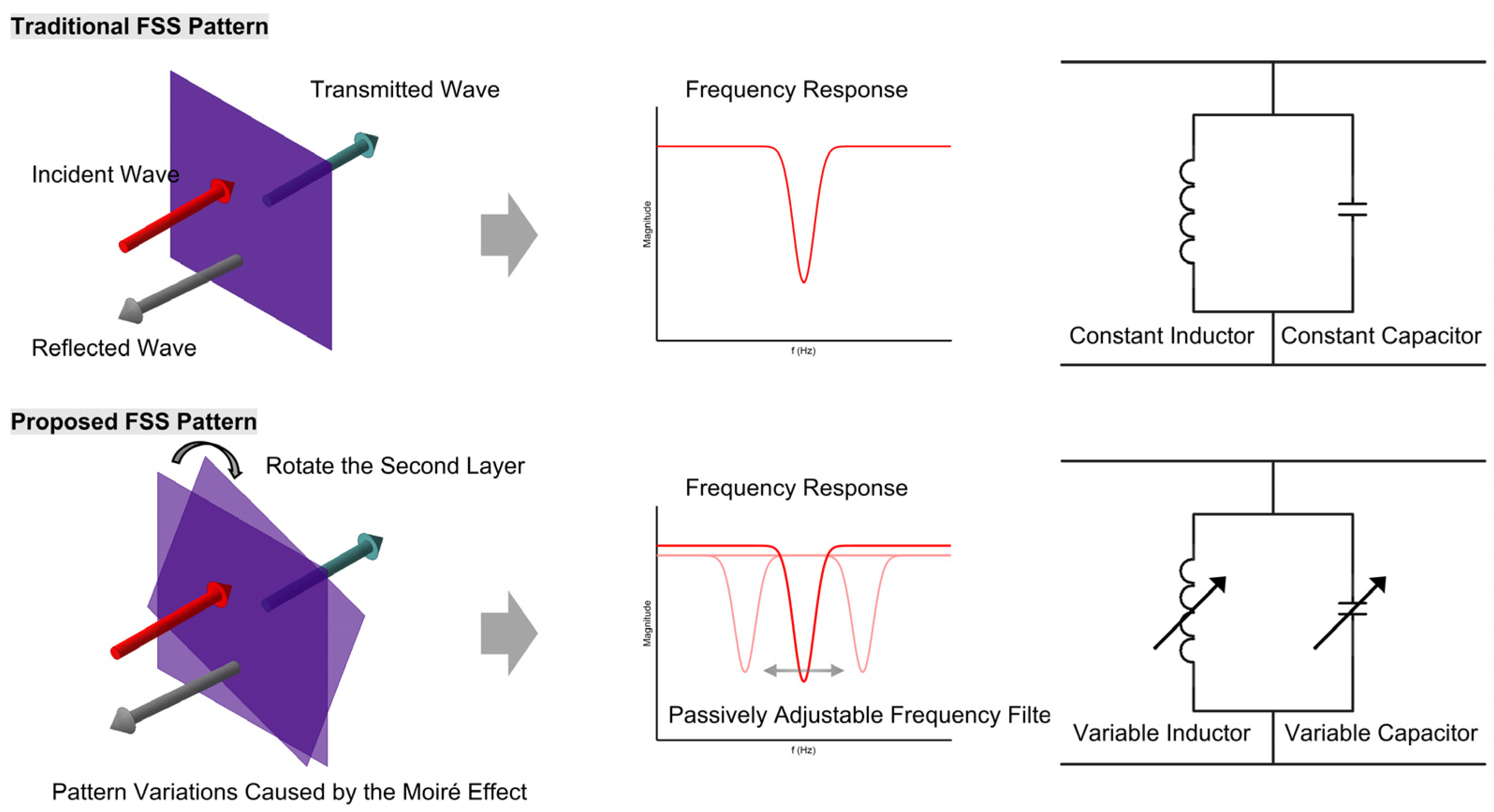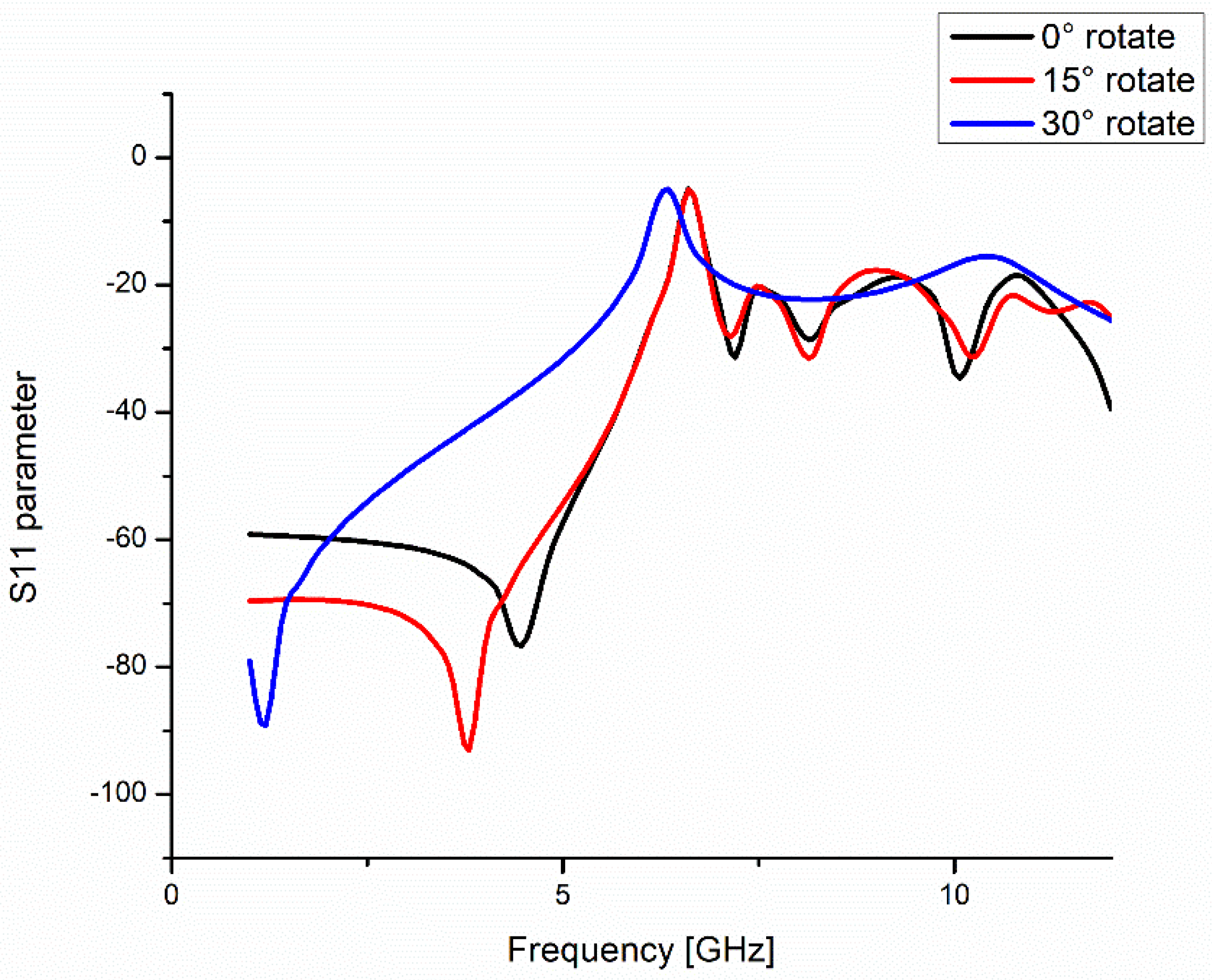Passive Frequency Tunability in Moiré-Inspired Frequency Selective Surfaces Based on Full-Wave Simulation
Abstract
1. Introduction
2. Theory and Background
2.1. Moiré Interference and Effective Periodicity
2.2. Frequency-Selective Surfaces and Resonance Behavior
- The effective inductance and capacitance of the pattern [17];
- The lattice periodicity, which affects phase accumulation [18];
- The substrate properties, such as dielectric constant [19].
2.3. Advantages of Moiré-Tuned Passive Structures
3. Materials and Methods
3.1. Unit Cell Design
3.2. Simulation Environment
4. Results
5. Discussion
6. Conclusions
Author Contributions
Funding
Data Availability Statement
Acknowledgments
Conflicts of Interest
References
- Gu, M.; Vorobiev, D.; Kim, W.S.; Chien, H.T.; Woo, H.M.; Hong, S.C.; Park, S., II. A novel approach using an inductive loading to lower the resonant frequency of a mushroom-shaped high impedance surface. Prog. Electromagn. Res. M 2020, 90, 19–26. [Google Scholar] [CrossRef]
- Hong, S.; Kim, W.S.; Park, S., II. Design of an inductive spiral-loop loaded unit cell in a mushroom-shaped high impedance surface for Sub-GHz applications. Prog. Electromagn. Res. M 2021, 100, 1–11. [Google Scholar] [CrossRef]
- Anwar, R.S.; Mao, L.; Ning, H. Frequency selective surfaces: A review. Appl. Sci. 2018, 8, 1689. [Google Scholar] [CrossRef]
- Ebrahimi, A.; Shen, Z.; Withayachumnankul, W.; Al-Sarawi, S.F.; Abbott, D. Varactor-tunable second-order bandpass frequency-selective surface with embedded bias network. IEEE Trans. Antennas Propag. 2016, 64, 1672–1680. [Google Scholar] [CrossRef]
- Sanphuang, V.; Ghalichechian, N.; Nahar, N.K.; Volakis, J.L. Equivalent circuit for VO2 phase change material film in reconfigurable frequency selective surfaces. Appl. Phys. Lett. 2015, 107, 253106. [Google Scholar] [CrossRef]
- Fan, Y.; Li, D.; Xing, J.; Ma, H.; Ang, L.K.; Li, E.-P. A Trifunctional Active Frequency Selective Surface for 6G Shielding Applications. IEEE Trans. Electromagn. Compat. 2024, 66, 1734–1743. [Google Scholar] [CrossRef]
- Kapoor, A.; Mishra, R.; Kumar, P. Frequency selective surfaces as spatial filters: Fundamentals, analysis and applications. Alex. Eng. J. 2022, 61, 4263–4293. [Google Scholar] [CrossRef]
- Sun, X.; Suriyage, M.; Khan, A.R.; Gao, M.; Zhao, J.; Liu, B.; Hasan, M.M.; Rahman, S.; Chen, R.; Lam, P.K. Twisted van der Waals quantum materials: Fundamentals, tunability, and applications. Chem. Rev. 2024, 124, 1992–2079. [Google Scholar] [CrossRef] [PubMed]
- Du, L.; Molas, M.R.; Huang, Z.; Zhang, G.; Wang, F.; Sun, Z. Moiré photonics and optoelectronics. Science 2023, 379, eadg0014. [Google Scholar] [CrossRef]
- Hong, S.; Hsiao, C.-T.; Cote, G.L. Simplified single neuron model for robust local pulse wave velocity sensing using a tetherless bioimpedance device. Biosens. Bioelectron. 2025, 267, 116793. [Google Scholar] [CrossRef]
- Hong, S.; Coté, G. Arterial Pulse Wave Velocity Signal Reconstruction Using Low Sampling Rates. Biosensors 2024, 14, 92. [Google Scholar] [CrossRef] [PubMed]
- Hong, S.; Coté, G. Development of a Tetherless Bioimpedance Device That Uses Morphologic Changes to Predict Blood Flow Restrictions Mimicking Peripheral Artery Disease Progression. Biosensors 2024, 14, 286. [Google Scholar] [CrossRef] [PubMed]
- Amidror, I. The Theory of the Moiré Phenomenon: Volume I: Periodic Layers; Springer Science & Business Media: New York, NY, USA, 2009; Volume 38, ISBN 1848821816. [Google Scholar]
- Konrad, J.; Agniel, P. Subsampling models and anti-alias filters for 3-D automultiscopic displays. IEEE Trans. Image Process 2006, 15, 128–140. [Google Scholar] [CrossRef] [PubMed]
- Hermann, K. Periodic overlayers and moiré patterns: Theoretical studies of geometric properties. J. Phys. Condens. Matter 2012, 24, 314210. [Google Scholar] [CrossRef]
- Wu, Z.; Zheng, Y. Moiré metamaterials and metasurfaces. Adv. Opt. Mater. 2018, 6, 1701057. [Google Scholar] [CrossRef]
- Rodríguez-Berral, R.; Mesa, F.; Medina, F. Systematic obtaining of Foster’s equivalent circuits for symmetric frequency selective surfaces. IEEE Trans. Antennas Propag. 2021, 70, 1166–1177. [Google Scholar] [CrossRef]
- Costa, F.; Monorchio, A.; Manara, G. An overview of equivalent circuit modeling techniques of frequency selective surfaces and metasurfaces. Appl. Comput. Electromagn. Soc. J. 2014, 29, 960–976. [Google Scholar]
- Haghzadeh, M.; Akyurtlu, A. All-printed, flexible, reconfigurable frequency selective surfaces. J. Appl. Phys. 2016, 120, 184901. [Google Scholar] [CrossRef]
- Munk, B.A. Frequency Selective Surfaces: Theory and Design; John Wiley & Sons: New York, NY, USA, 2005; ISBN 0471723762. [Google Scholar]
- Ahmad, R.; Zhuldybina, M.; Ropagnol, X.; Trinh, N.D.; Bois, C.; Schneider, J.; Blanchard, F. Reconfigurable terahertz moiré frequency selective surface based on additive manufacturing technology. Appl. Sci. 2023, 13, 3302. [Google Scholar] [CrossRef]
- Carvalho, S.S.; Reis, J.R.V.; Caldeirinha, R.F.S. A state-of-the-art review on 4D printed antennas and other adaptable designs. IEEE Access 2024, 12, 62861–62881. [Google Scholar] [CrossRef]
- Krasnok, A.; Alú, A. Low-symmetry nanophotonics. ACS Photonics 2022, 9, 2–24. [Google Scholar] [CrossRef]
- Khajevandi, A.; Oraizi, H. Miniaturization of frequency selective surface by 2.5-dimensional meandered split ring cells for application in L-band. Sci. Rep. 2023, 13, 18737. [Google Scholar] [CrossRef]
- Suganya, A.; Natarajan, R. Polarization Insensitive Dual Band FSS for S-Band and X-Band Applications. Prog. Electromagn. Res. Lett. 2023, 110, 37–45. [Google Scholar] [CrossRef]
- Paik, H.; Premchand, K. Performance Analysis of a Single Layer X-Band Frequency Selective Surface Based Spatial Filter Implementing Half Jerusalem Cross Slot. Prog. Electromagn. Res. Lett. 2023, 108, 25–30. [Google Scholar] [CrossRef]
- Coutinho, I.; Madeiro, F.; Queiroz, W. Cascaded Frequency Selective Surfaces with Matryoshka Geometry for Ultra-Wideband Bandwidth. Appl. Sci. 2024, 14, 8603. [Google Scholar] [CrossRef]
- Zhao, P.-C.; Zong, Z.-Y.; Wu, W.; Li, B.; Fang, D.-G. An FSS structure with geometrically separable meander-line inductors and parallel-plate capacitors. IEEE Trans. Antennas Propag. 2017, 65, 4693–4705. [Google Scholar] [CrossRef]
- Guo, C.; Yu, J.; Deng, S. Hybrid metasurfaces of plasmonic lattices and 2D materials. Adv. Funct. Mater. 2023, 33, 2302265. [Google Scholar] [CrossRef]
- Mamedes, D.F. Design of Frequency-Selective Surfaces for Advanced Applications. Ph.D. Thesis, University of Victoria, Victoria, BC, Canada, 2024. [Google Scholar]
- Xing, H.; Fan, J.; Lu, D.; Gao, Z.; Shum, P.P.; Cong, L. Terahertz metamaterials for free-space and on-chip applications: From active metadevices to topological photonic crystals. Adv. Devices Instrum. 2022, 2022, 9852503. [Google Scholar] [CrossRef]
- Wu, Z. Plasmonic Moiré Metamaterials and Metasurfaces: Tunable Optical Properties and Nanophotonic Applications. Ph.D. Thesis, The University of Texas at Austin, Austin, TX, USA, 2018. [Google Scholar]
- Taoum, J. Two Novel Low Energy Mechanically Reconfigurable Antennas Based on Chladni and Moiré Patterns. Master’s Thesis, American University of Beirut, Beirut, Lebanon, 2021. [Google Scholar]
- Tripon-Canseliet, C. Optical Reconfiguration of Microwave Functionalities: From Nanomaterials to Sub-Systems. Ph.D. Thesis, Sorbonne University, Paris, France, 2019. [Google Scholar]
- Cao, Y.; Torres, D.; Wang, T.; Tan, X.; Sepúlveda, N. Enabling tunable micromechanical bandpass filters through phase-change materials. Smart Mater. Struct. 2017, 26, 85032. [Google Scholar] [CrossRef]
- Singh, T.; Khaira, N.K.; Mansour, R.R. Thermally actuated SOI RF MEMS-based fully integrated passive reflective-type analog phase shifter for mmWave applications. IEEE Trans. Microw. Theory Tech. 2020, 69, 119–131. [Google Scholar] [CrossRef]
- Adhikari, S.; Wu, K. Developing one-dimensional electronically tunable microwave and millimeter-wave components and devices towards two-dimensional electromagnetically reconfigurable platform. Prog. Electromagn. Res. 2013, 143, 821–848. [Google Scholar] [CrossRef]
- Mehrotra, P.; Chatterjee, B.; Sen, S. EM-wave biosensors: A review of RF, microwave, mm-wave and optical sensing. Sensors 2019, 19, 1013. [Google Scholar] [CrossRef]
- Emami-Nejad, H.; Mir, A. Design and simulation of a flexible and ultra-sensitive biosensor based on frequency selective surface in the microwave range. Opt. Quantum Electron. 2017, 49, 320. [Google Scholar] [CrossRef]
- Zhang, J.; Mu, N.; Liu, L.; Xie, J.; Feng, H.; Yao, J.; Chen, T.; Zhu, W. Highly sensitive detection of malignant glioma cells using metamaterial-inspired THz biosensor based on electromagnetically induced transparency. Biosens. Bioelectron. 2021, 185, 113241. [Google Scholar] [CrossRef]
- Hsiao, C.-T.; Hong, S.; Branan, K.L.; McMurray, J.; Coté, G.L. Predicting blood pressure without a cuff using a unique multi-modal wearable device and machine learning algorithm. Comput. Biol. Med. 2025, 192, 110357. [Google Scholar] [CrossRef] [PubMed]
- Hong, S.; Coté, G. Minimization of Parasitic Capacitance between Skin and Ag/AgCl Dry Electrodes. Micromachines 2024, 15, 907. [Google Scholar] [CrossRef]
- Esfandiari, M.; Zhu, J.; Yang, Y. Additively manufactured metasurfaces and metamaterials: Designs, fabrications, and applications from microwave to photonics. APL Photonics 2025, 10, 041101. [Google Scholar] [CrossRef]
- Hong, I.-P. Reviews based on the reconfigurable intelligent surface technical issues. Electronics 2023, 12, 4489. [Google Scholar] [CrossRef]
- Shaltout, A.M.; Shalaev, V.M.; Brongersma, M.L. Spatiotemporal light control with active metasurfaces. Science 2019, 364, eaat3100. [Google Scholar] [CrossRef]
- Yu, N.; Capasso, F. Flat optics with designer metasurfaces. Nat. Mater. 2014, 13, 139–150. [Google Scholar] [CrossRef]
- Liu, S.; Ma, S.; Shao, R.; Zhang, L.; Yan, T.; Ma, Q.; Zhang, S.; Cui, T.J. Moiré metasurfaces for dynamic beamforming. Sci. Adv. 2022, 8, eabo1511. [Google Scholar] [CrossRef] [PubMed]
- Wang, Y.H.; Pang, C.; Wang, Y.; Qi, J. Electromagnetic Manipulation Evolution from Stacked Meta-Atoms to Spatially Cascaded Metasurfaces. Ann. Phys. 2025, 537, 2400158. [Google Scholar] [CrossRef]
- Fan, Z.; Qian, C.; Jia, Y.; Feng, Y.; Qian, H.; Li, E.-P.; Fleury, R.; Chen, H. Holographic multiplexing metasurface with twisted diffractive neural network. Nat. Commun. 2024, 15, 9416. [Google Scholar] [CrossRef] [PubMed]
- Gamero, M.; Kim, W.S.; Hong, S.; Vorobiev, D.; Morgan, C.D.; Park, S., II. Multimodal sensing capabilities for the detection of shunt failure. Sensors 2021, 21, 1747. [Google Scholar] [CrossRef]
- Blazquez, B.; Llombart, N.; Cavallo, D.; Freni, A.; Neto, A. A rigorous equivalent network for linearly polarized THz absorbers. IEEE Trans. Antennas Propag. 2014, 62, 5077–5088. [Google Scholar] [CrossRef]
- Ericsson, A. Design and Characterization of Functional Structures for Electromagnetic Waves. Ph.D. Thesis, Lund University, Lund, Sweden, 2017. [Google Scholar]
- Cen, M.; Wang, J.; Cheng, M.; Lei, Z.; Li, Y.; Wang, Z.; Zhao, X.; Wu, Z.; Zhang, H.; Liu, Y.J. Moiré metasurfaces with tunable near-infrared-I chiroptical responses for biomolecular chirality discrimination. Nanoscale 2025, 17, 1970–1979. [Google Scholar] [CrossRef]
- Han, Z.; Wang, F.; Sun, J.; Wang, X.; Tang, Z. Recent advances in ultrathin chiral metasurfaces by twisted stacking. Adv. Mater. 2023, 35, 2206141. [Google Scholar] [CrossRef]
- Yao, L.; Yang, W.; Zhou, S.; Mei, H.; Li, Y.; Dassios, K.G.; Riedel, R.; Liu, C.; Cheng, L.; Zhang, L. Top-down parametrization-design of orientation-reinforced SiOC-based perfect metamaterial microwave absorber with wide-temperature adaptability. Acta Mater. 2023, 249, 118803. [Google Scholar] [CrossRef]
- Woo, H.-M.; Kim, W.S.; Hong, S.; Jeevakumar, V.; Smithhart, C.M.; Price, T.J.; Yoon, B.-J.; Park, S., II. Machine Learning Enabled Adaptive Wireless Power Transmission System for Neuroscience Study. In Proceedings of the 2020 54th Asilomar Conference on Signals, Systems, and Computers, Pacific Grove, CA, USA, 1–4 November 2020; pp. 808–812. [Google Scholar]
- Hong, S. Wireless Optogenetic Microsystems Accelerate Artificial Intelligence–Neuroscience Coevolution Through Embedded Closed-Loop System. Micromachines 2025, 16, 557. [Google Scholar] [CrossRef]
- Hong, S.; Kim, W.S.; Han, Y.; Cherukuri, R.; Jung, H.; Campos, C.; Wu, Q.; Park, S., II. Optogenetic Targeting of Mouse Vagal Afferents Using an Organ-specific, Scalable, Wireless Optoelectronic Device. Bio-Protocol 2022, 12, e4341. [Google Scholar] [CrossRef]





Disclaimer/Publisher’s Note: The statements, opinions and data contained in all publications are solely those of the individual author(s) and contributor(s) and not of MDPI and/or the editor(s). MDPI and/or the editor(s) disclaim responsibility for any injury to people or property resulting from any ideas, methods, instructions or products referred to in the content. |
© 2025 by the authors. Licensee MDPI, Basel, Switzerland. This article is an open access article distributed under the terms and conditions of the Creative Commons Attribution (CC BY) license (https://creativecommons.org/licenses/by/4.0/).
Share and Cite
Hwang, J.; Hong, S. Passive Frequency Tunability in Moiré-Inspired Frequency Selective Surfaces Based on Full-Wave Simulation. Micromachines 2025, 16, 702. https://doi.org/10.3390/mi16060702
Hwang J, Hong S. Passive Frequency Tunability in Moiré-Inspired Frequency Selective Surfaces Based on Full-Wave Simulation. Micromachines. 2025; 16(6):702. https://doi.org/10.3390/mi16060702
Chicago/Turabian StyleHwang, Jieun, and Sungcheol Hong. 2025. "Passive Frequency Tunability in Moiré-Inspired Frequency Selective Surfaces Based on Full-Wave Simulation" Micromachines 16, no. 6: 702. https://doi.org/10.3390/mi16060702
APA StyleHwang, J., & Hong, S. (2025). Passive Frequency Tunability in Moiré-Inspired Frequency Selective Surfaces Based on Full-Wave Simulation. Micromachines, 16(6), 702. https://doi.org/10.3390/mi16060702






